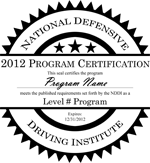
| The demand for driver education that exceeds state operated programs continues to increase. However, parents are justifiably reluctant to enroll their students in any program that will give their students experience they consider overly-aggressive or inappropriate for an inexperienced driver. With an understanding of the leading causes of crashes, and the inherent weaknesses of new drivers, we have evaluated the various content and approaches utilized by today's leading programs. It has been determined there are threads of consistency between the most successful programs. Defensive Driving programs meeting the following requirements may submit to be certified. Contact the NDDI at: programcertification@nationaldefensivedrivinginstitute.org In order to be eligible for certification by the National Defensive Driving Institute, any driver training program must adhere to the following expectations: Program Format: By definition, a "defensive" move is made as a result of and "offensive" move which turned a Normal Driving Condition in to an Emergency Driving Condition. Therefore, a program desirous of being classified as a "Defensive Driving" program, can only be a behind-the-wheel, skill training program training students in the proper execution of appropriate, defensive maneuvers in Emergency Driving Conditions.
All programs must carry a minimum of $1,000,000 in liability insurance to any venue they attend. Program Content
Limits of Steering:
Limits and Maintenance of Acceleration:
Limits of Braking:
Crash Avoidance:
Instructors:
Consumer alert: To verify the NDDI Certification of any Defensive Driving program:
|
||||||||||||||||||||||||||||||||||||||||||||||||||||||||||||||||||||||||||||||||||||||||||||||||||||||||||||||||||||||||||||||||||||||||||||||||||||||||||||||||||
